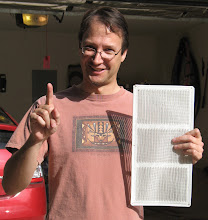Let's take a quick moment here to point out a basic point about this blog so far. Despite technical discussions about heat transfer and complicated graphs with curves and lines on them, the actual things we're doing to the house are pretty simple. Other than replacing the broken air conditioner, every significant improvement I've made to the house is "geezer tech": something that your grandfather could well have done 50 years ago. This includes things like sealing up ducts, considering attic airflow for cooling, and for the imaginative granddads, perhaps even putting up reflective material to bounce the sun's heat back out. (My own father actually did this many years ago with part of his house, using kitchen aluminum foil ... it must run in the family).
The other thing to point out is that there are other ways of achieving energy savings than actually doing something to your house. One significant factor which I haven't really captured is the effect of the slowly growing shade trees around my house. We started in this house with tiny oaks on the west side of the house, but they had no effect until about 5 years in, when they had grown enough to provide shade over the west-facing kitchen windows in the hot afternoons. The kitchen cooled dramatically that year (this was before 2005, when I started taking data; I shudder to think what _those_ graphs would have looked like). There must have indeed been some good energy savings; shade trees are Nature's radiant barrier.
Another way to save energy, if you're designing or planning your own house, is to use passive solar design, something that was done rather poorly with the layout of my house. Since the sun travels further north (in this hemisphere anyway) in the summer, and further south in the winter, you can put your maximum window area facing south, where the incoming solar energy helps you the most in winter, and hurts you the least in summer. Of course, in my "energy efficient" home, the north-facing wall has 5 times the window area of the south-facing wall, meaning that I've got the exact opposite of what I should for this area. In addition, as it turns out, the positioning of my eastern neighbor's trees gives me great shade in the winter, when I don't want it, and only partial shade in the summer, when I could really use it.
I am still considering planting another tree that would give my east-facing back porch some nice shade in the summer, but who's shadow would miss the house in the winter; a sort of passive solar tree design. Unfortunately, that same tree will likely shade some of my northern neighbor's south-facing windows during the winter, so I need to be careful with the placement.
Anyway, the point of this little post is to remind folks that this isn't rocket science, it's really not all that technical in terms of the actions we're taking, and it's really not all that difficult. A 50% reduction in energy usage doing things that your grandfather probably knew how to do really seems like, well, a no-brainer. Energy efficiency waits for no man! What are you waiting for?
Subscribe to:
Post Comments (Atom)


No comments:
Post a Comment